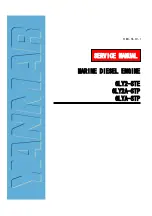
10
MHD56208 - Edition 3
INSPECTION
Inspection information is based in part on American Society of
Mechanical Engineers Safety Codes (ASME B30.7).
• All new or repaired equipment should be inspected and
tested by personnel instructed in safety, operation and
maintenance of this equipment to ensure safe operation at
rated specifications before placing equipment in service.
• Never use a motor that inspection indicates is damaged.
Frequent and periodic inspections should be performed on
equipment in regular service. Frequent inspections are visual
examinations performed by operators or personnel trained in
safety and operation of this equipment and include observations
made during routine equipment operation. Periodic inspections are
thorough inspections conducted by personnel trained in the safety,
operation and maintenance of this equipment.
ASME B30.7 states inspection intervals depend upon the nature of
the critical components of the equipment and the severity of
usage. The inspection intervals recommended in this manual are
based on intermittent operation of the motor eight hours each day,
five days per week, in an environment relatively free of dust,
moisture, and corrosive fumes. If the motor is operated almost
continuously or more than eight hours each day, more frequent
inspections will be required.
Careful inspection on a regular basis will reveal potentially
dangerous conditions while still in the early stages, allowing
corrective action to be taken before condition becomes dangerous.
Deficiencies revealed through inspection, or noted during
operation, must be reported to designated personnel instructed in
safety, operation and maintenance of this equipment. A
determination as to whether a condition constitutes a safety hazard
must be decided, and the correction of noted safety hazards
accomplished and documented by written report before placing
the equipment in service.
Records and Reports
Inspection records, listing all points requiring periodic inspection
should be maintained for all load bearing equipment. Written
reports, based on severity of service, should be made on the
condition of critical parts as a method of documenting
periodic
inspections. These reports should be dated, signed by the person
who performed the inspection, and kept on file where they are
readily available for authorized review.
Frequent Inspection
On equipment in continuous service, frequent inspection should
be made by operators at the beginning of each shift. In addition,
visual inspections should be conducted during regular operation
for indications of damage or evidence of malfunction (such as
abnormal noises).
1.
Motor
. During operation check motor housing for excess
heat build up. Housing should not be hot to the touch. Listen
for grinding or knocking noises in motor. There should be no
grinding or knocking noises. If equipped with a lubricator,
check lubricated air supply provides a minimum of 3 drops
per minute (6-8 for Air Spring Operation) of ISO VG 32
(10W SAE) oil. Operate motor slowly in both directions to
verify operation.
2.
Natural Gas Operation (optional feature)
. Check all
connections and fittings with a suitable leak detector. Repair
all leaks.
• Operating motor with natural gas will reduce motor life.
Frequency of inspections should be increased. Refer to
Inspection Intervals on page 10.
• Natural gas may contain high levels of sulphur, which will
result in sulfuric acid (‘Sour Gas’) in air system. This acid is
very corrosive and will cause motor seals, ‘O’ rings, rotating
shafts and bearings to deteriorate at a greater rate than those
exposed to compressed air.
Periodic Inspection
Motor periodic inspection intervals vary depending on conditions
listed below:
Disassembly may be required as a result of frequent inspection
findings or in order to properly inspect individual components.
Disassembly steps are described in “MAINTENANCE” section.
Maintain written records of periodic inspections to provide an
accumulative basis for continuing evaluation. Inspect all items
listed in ‘Frequent Inspection.’ Also inspect the following:
1.
Air Motor
. Inspect piston rings for signs of uneven wear.
With rings installed on piston, and piston in cylinder liner,
measure end gap. If total gap (sum of both sides) is 0.09 inch
(2.3 mm) or more, replace rings. If rib of ring (thickest
section) is less than 0.135 inch (3.4 mm), replace rings. Refer
to Dwg. MHP2084 on page 11. Refer to ‘Inspection’ on page
15 in “MAINTENANCE” section for additional inspections
when motor is disassembled.
Dry Air (Lube-free)
NORMAL
HEAVY
SEVERE
quarterly
monthly
weekly
Natural Gas - Normal
NORMAL
HEAVY
SEVERE
semiannually
quarterly
monthly
Natural Gas - ‘Sour Gas’
NORMAL
HEAVY
SEVERE
quarterly
monthly
weekly
Содержание MMP150
Страница 5: ...MHD56208 Edition 3 5 Dwg MHP2004...
Страница 23: ...MHD56208 Edition 3 23 SERVICE NOTES...
Страница 26: ...26 MHD56208 Edition 3 SERVICE NOTES...
Страница 36: ...www irtools com...











































